A quick look around any pet supply store and you’ll see no shortage of cute and functional cat bowls. Stainless steel, ceramic and plastic bowls beckon–but which should you choose for your cat?
We’ve got the rundown on how to choose a cat bowl to avoid whisker stress, avoid cat acne, help prevent fast eating and avoid ants!
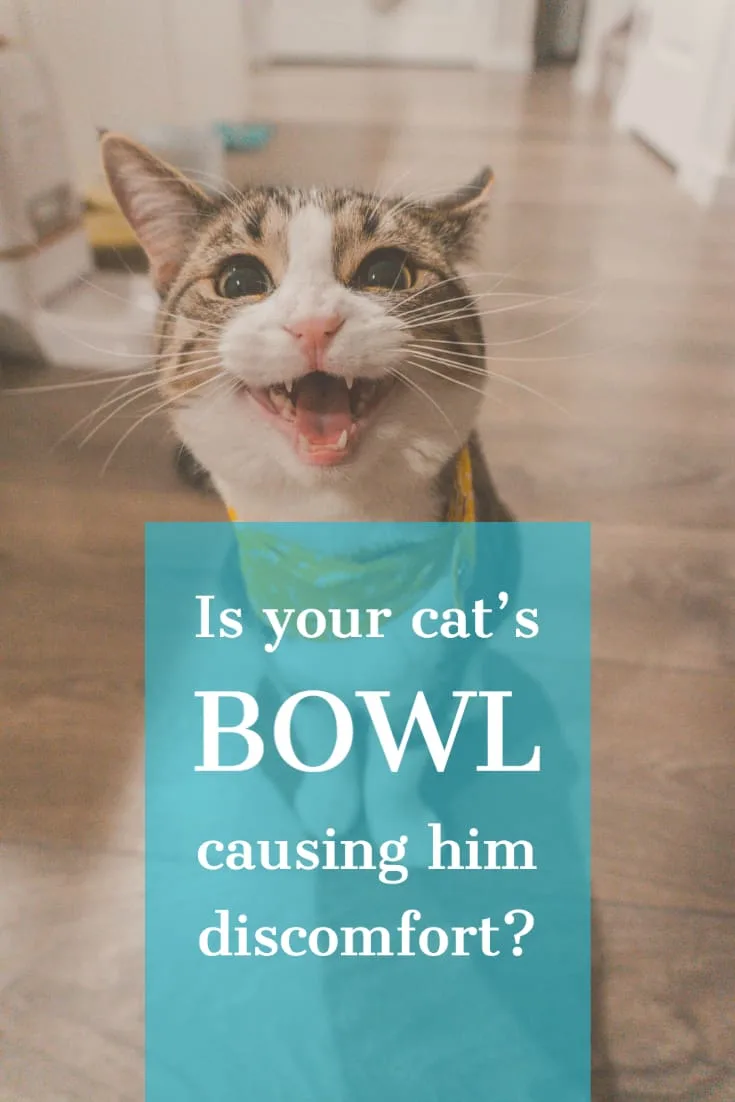
Whisker Stress and Cat Bowls
Does your cat have whisker stress? He just might.
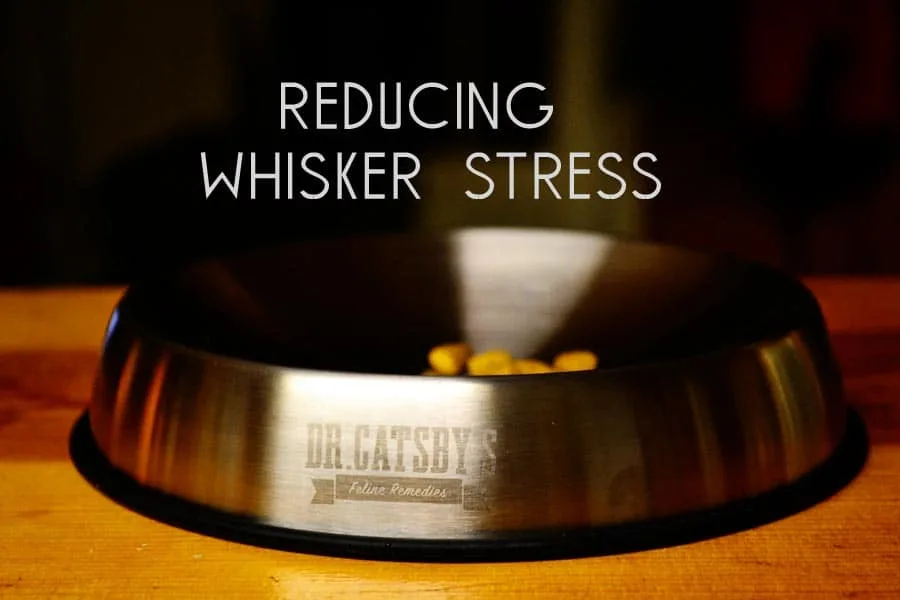
Years ago, when I was more concerned about fashion trends than I am now, I had some sunglasses that sat oddly on my face. They looked fine and were fashionable…but when I blinked, my eyelashes would occasionally brush the glasses. It was endlessly annoying and disconcerting. I soon got rid of the glasses.
Well, imagine the sensitivity of our cats’ whiskers. Like our eyelashes, they’re more sensitive than other hairs–but more so. And, like our eyelashes, those whiskers need some elbow room! They don’t want to be crowded in a bowl, brushing up against the sides with every drink or bite.
After all, your cat’s whiskers are finely tuned instruments designed to detect the slightest touch, the faintest change of breeze. Helping him to hunt and navigate, they’re important instruments that he protects–and that means not putting his head into a bowl that’s too small.
If your cat is given a bowl that’s a squeeze for those whiskers, he might simply eat the food on top–or he might start dipping his foot in the food and pulling it out on the floor or grabbing mouthfuls of food to drop and eat on the floor where those whiskers will have plenty of space.
How do you know if your cat is being bothered by whisker stress? The common signs are:
- pulling food out of the bowl and onto the floor
- pawing at the food
- becoming aggressive to other cats at mealtime
- not eating
We feed our cats on white dessert plates. I purchased a dozen of the plates for 25 cents each at our local thrift store; they’re restaurant quality so they’re extra heavy. (With two large dogs in the house, we have to consider the fact that, sooner or later, a dog may decide to pick up one of the cat plates and walk off with it.)
Another option is Dr. Catsby’s Bowl for Whisker Relief, specially designed to permit your cat to dine in comfort. The stainless steel bowl is wide and shallow; it ships with a mat so the bowl stays in place while your cat dines.
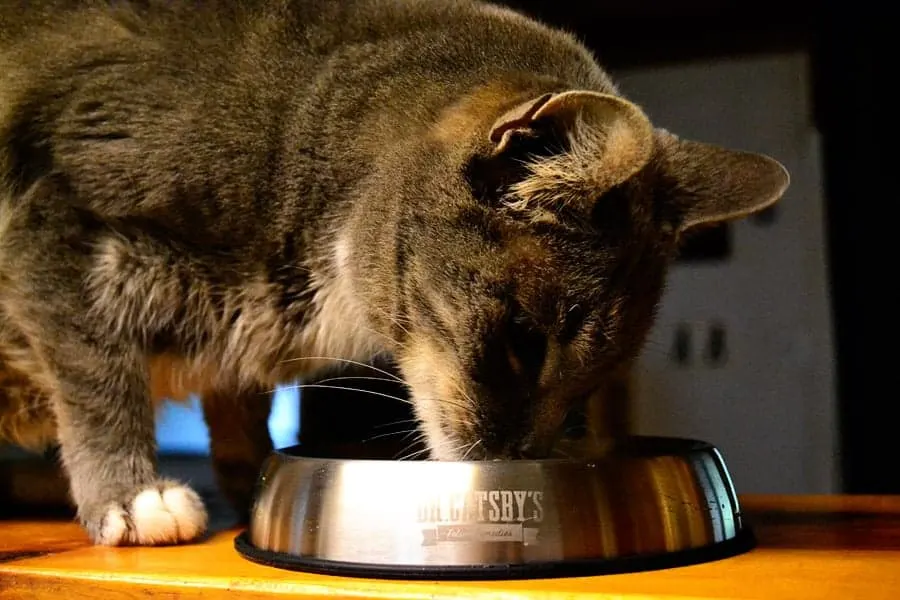
Linus did great with the Dr. Catsby bowl; he happily ate from the bowl and the food stayed IN the bowl until he ate it–no more cleaning up the surrounding floor! We give Dr. Catsby’s a big paws up, both for its functionality and for its sleek design.
We also have extra-large water options for our cats. We use a Drinkwell pet fountain (the Big Dog model, since the fountain is shared between four cats and two large dogs). As you can see, the cats have plenty of whisker space in the bowl portion of the fountain.
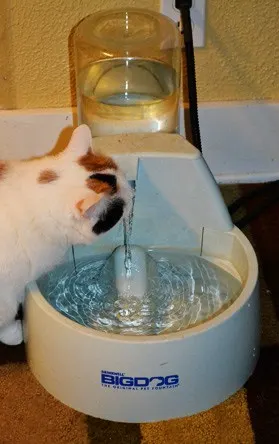
Extra wide bowls are another inexpensive option for your cat’s water that won’t crowd the whiskers.
Preventing whisker stress is easy to do with just a little forethought. Forgo small cat bowls (no matter how cute they might be!) in favor of plates or extra wide bowls, and you’ll have your cat–and those whiskers–purrfectly happy with your selections!
Bowls to Avoid Cat Acne
Years ago, we fed our cats from super cute plastic dishes with cat emblems and bright colors. The dishes were so cute, they were unbreakable…and they gave Linus terrible chin acne.
The acne began with just a couple of bumps and some blackheads on his chin and then it progressed. Soon his entire chin was inflamed. We washed it with special cat shampoo. Nothing helped the cat acne.
Cat acne is a common condition caused by blocked follicles. Look for blackheads on your cat’s chin (and less commonly on the lower lip).
Just when we were about to head to the veterinarian, we learned that plastic bowls can give many cats chin acne. Plastic bowls have tiny scratches and crevices that can harbor bacteria. When a cat eats or drinks from a plastic bowl, its chin may come into contact with these bacteria, potentially leading to skin irritation and acne.
Because the plastic provides an easy resting place for bacteria which can easily spread from cat to cat, most veterinarians suggest that you feed your cats in glass bowls, dinnerware, or stainless steel. Regardless of the material, it’s essential to clean your cat’s food and water bowls regularly. Wash them with hot, soapy water and rinse thoroughly to remove any residue.
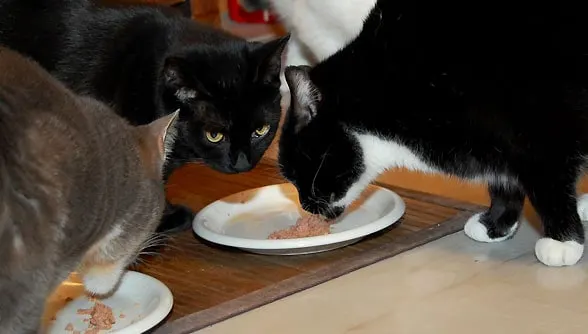
Again, our white dessert-sized plates we purchased to avoid whisker stress solve the cat acne problem. Each cat gets his own plate (although they always do some plate-hopping, as in this photo) and each plate goes through the dishwasher daily, since we have a large supply of plates.
And the acne? It disappeared the very week we switched from plastic bowls to dinnerware!
Slow Feeder Cat Bowl
We’ve long been acquainted with slow feeder bowls for our dogs; these are basically bowls with obstructions that require the dog to eat around the raised portion of the bowl to slow his eating.
Slow feeder bowls are also available for cats, perfect for cats who gulp their meals. Besides often causing cats to overeat, fast eating can also cause your cat to regurgitate food…and no one wants that.
Slow feeder bowls are made with a maze or with “fingers” that slow your cat’s eating.
Unlike a slow feeder bowl for a dog, which has raised sides, slow feeder bowls for cats are generally flatter and shaped more like a plate to avoid whisker stress.
Ant-Proof Cat Bowl
Whether you are feeding a feral colony or, like us, you have the challenge of ants in the house during warm weather months, an ant-proof cat bowl protects your food and your cat.
You can sit your cat bowl in a shallow baking pan filled with a little water to prevent ants from crossing into the bowl, or look for specially-designed ant-proof cat bowls.
These bowls are designed with a moat around the food compartment to prevent ants from crossing into the bowl itself.
Spend a few minutes analyzing your cat’s bowls to see if you could make your cat’s dining and drinking more comfortable!
FAQ
Do cats prefer bowls or plates?
Cats generally do not have a strong preference for bowls or plates, and their preference may vary from one individual to another. (In our house, plates are the winner.)
One downside of plates that we see every day: Cats can be messy eaters, and some cats may be more likely to push food out of a plate compared to a bowl. Bowls can help contain spills and make cleanup easier.
To determine your cat’s preference, you can try offering both a bowl and a plate and see which one your cat seems to prefer. It’s essential to prioritize your cat’s comfort and ensure that they can eat their meals without any issues.
How large should a cat bowl be?
The bowl should be large enough to comfortably accommodate your cat’s face and whiskers without them touching the sides of the bowl. Cats can be sensitive to their whiskers touching objects, which can be uncomfortable for them. If your cat’s whiskers are often pushed back while eating, consider a wider and shallower bowl.
Related Posts
Can I Add Water to My Cat’s Dry Food?
7 Ways to Get Your Cat To Drink More Water
Felaqua Connect Smart Water Bowl for Cats
- 🎉 GIVEAWAY: Lord of the Pets Portrait of Your Cat! - November 26, 2024
- Review: Lord of the Pets Cat Portraits! - November 26, 2024
- Cat Adoption: FAQ You Might Have - June 28, 2024
